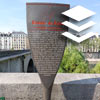
The ultimate street signs, historical sites and house numbers
 Click for a larger image
Click for a larger image  Click for sign's details
Click for sign's details  Click for all signs belonging to The History of Paris (Starck's Lollipops)
Click for all signs belonging to The History of Paris (Starck's Lollipops)
 136 Meter |
136 Meter |  137 Meter |
137 Meter |  177 Meter |
177 Meter |  188 Meter |
188 Meter |  259 Meter
259 Meter